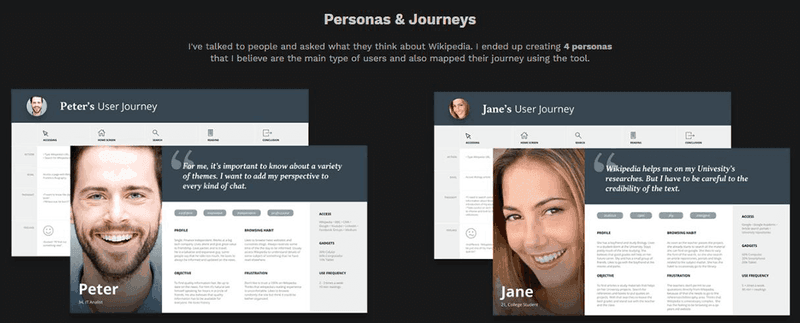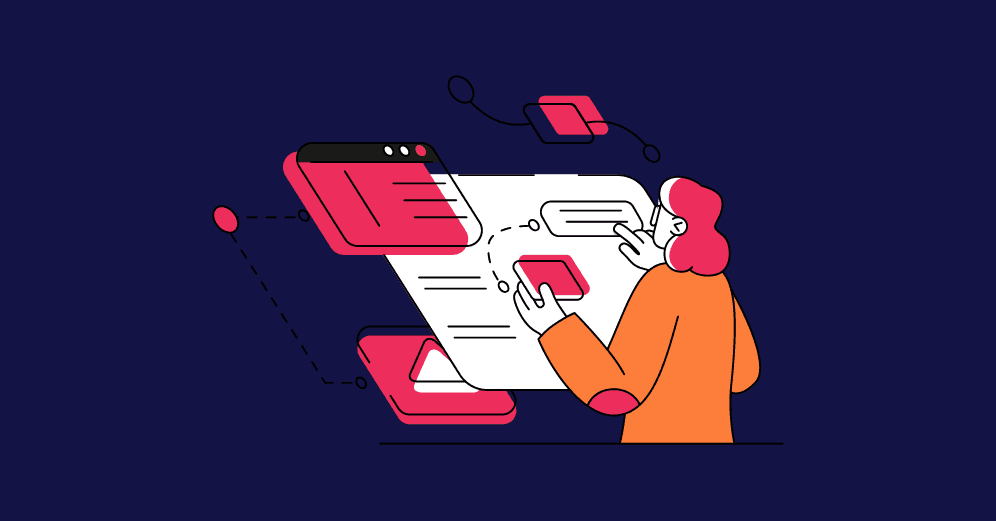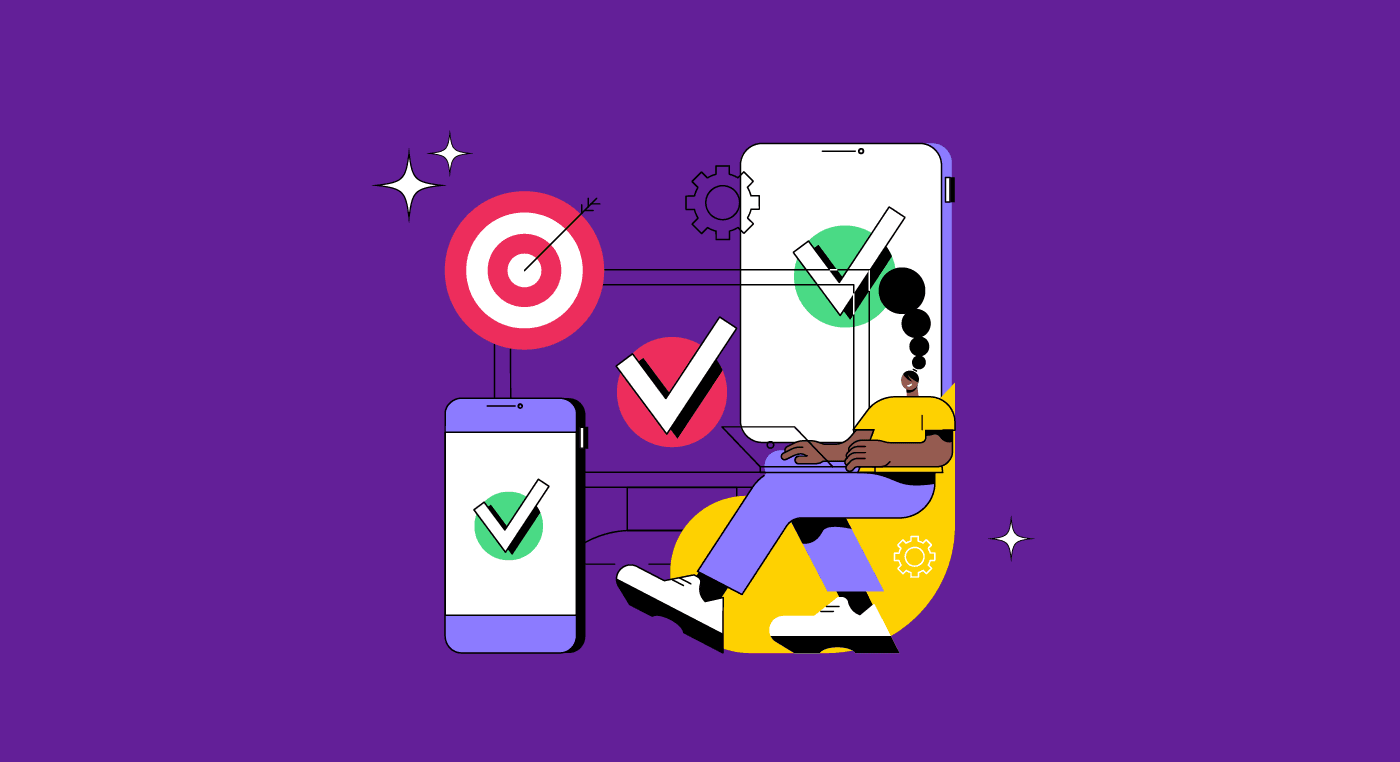The concept of Persona is crucial and widely used in the field of UX/UI Design, whether it's when creating your portfolio or working on a project.
Essentially, a persona represents the users of a particular product or service, enabling the development of solutions that best meet their needs.
Read on to learn more about how to create and utilize personas in your UX Design projects.
Difference between persona and target audience
First and foremost, it's essential to clarify a common misconception: Persona and target audience are distinct concepts!
Target audience
It is a group of people who share similar characteristics, such as behavior and social class. It refers to a more general definition, not just a specific person.
Example of a women's clothing store's target audience:
- Women between 40 and 50 years old, living in São Paulo, and with monthly income above 8 minimum wages.
Persona
The persona, on the other hand, is represented by a fictitious ideal customer with a specific definition of characteristics. It is created based on a survey of the behavior and real attributes of its customers with detailed information.
An example is the persona of a women's clothing store:
- Joana is 50 years old, lives in São Paulo, and loves to chat with her friends on WhatsApp, use Facebook, and go to events. She wants to be perceived as a more serious and professional woman.
Reading Tip: User Interview: Keys To Gather Insightful Information

UX/UI Design focused on the persona
As a general trend, people are becoming increasingly discerning about what they consume. As a result, there is a growing need for customized products and services that cater to their specific needs.
So how can you do this? By knowing well who your user is, that is, your persona!
For the UX Designer, the persona is a tool that helps understand your audience more deeply in order to create solutions based on the concept of User-Centered Design.
This way, it's not enough just to have a lot of data about the target audience. It's necessary to segment, group, and humanize them to identify who your persona really is.
With these definitions in hand, the project team can:
- Always have in mind for whom the product is being developed;
- Make decisions according to the persona's profile;
- Have a common goal and focus.
With the creation of a persona, the people involved in the project can make decisions based on real data, instead of individual opinions and guesswork.
The importance of a persona in UX Design
The main purpose of a persona is to create reliable representations of your users, for reference and future projects.
With this approach, companies can develop more customized products and reach more specific niches within a more competitive market. As a consequence, the use of personas can help improve revenue and gain new users for the business.
In addition, creating a persona can also help with the segmentation of analytical data. This separation reduces the huge amount of user data that needs to be analyzed by the UX Designer.

Reading Tip: Design System: How To Create One?
What are the benefits of using personas?
The benefits of creating a persona are many and for everyone involved – company, client, Designer, and user. It provides a much better-targeted product or service.
By identifying the actual end user of the project, the often multidisciplinary team can focus on making the decisions involved. In addition, the persona can be used in all phases of the project and by all professionals involved, such as:
- Stakeholders: they evaluate new project ideas and requirements and make decisions related to them;
- Information Architects: develop proposals for solutions that are consistent with user behavior;
- Visual Designers: create the overall look and feel of the product according to the persona;
- Developers: decide which approach to take based on user behaviors;
- Copywriters/ UX Writers: ensure that the content and language are suitable for the persona.
Moreover, using personas allows decisions to be made based on the end user, research, and data. This way, decisions based on personal opinions and tastes are avoided.
Portfolio
Personas should not only be used in real projects. In fact, they are also essential for you to develop design exercises and redesigns for your portfolio.
As they are the main part of every project, personas should also be present in your portfolio because they help demonstrate the line of reasoning by which you developed your interface.
In this regard, the use of personas is also beneficial for composing your portfolio and giving more depth to your presentation in interviews for job opportunities.

Reading Tip: How To Use Storytelling To Promote Your Career
Which criteria should be used and how to create a persona?
A project can have more than one persona, but it's still important that the UX/UI Designers limit themselves to the main groups.
Ideally, it's best to create no more than three or four personas per project. Creating more than that can make the project overly complex, and the resulting product may not adequately address all problems in a satisfactory manner.
To ensure that the personas truly represent the end user, the UX/UI Designer should:
- Conduct user research in order to understand who your customer is, why they would use your product or service, and what their behaviors and expectations are;
- Brainstorm with professionals from other areas, organizing and even creating elements that represent your target audience;
- Refine as much as possible so as to create no more than three or four personas for a single project;
- Turn them into real people, developing backstories and creating motivations and expectations for the final product.
Focus on involving more people in the creation of the personas. That way there are more insights and information that contribute to this development.
Additional persona information
After identifying the most outstanding characteristics of users, you can group or eliminate similar attributes based on the company's interests. Once the details appear, the Designer can add them to the persona to make it more realistic.
Some of the information commonly added to the persona is:
- Name, age, gender, and photo, the latter mainly in portfolios;
- Description of what they do in real life – here, the design team should keep a professional tone;
- Level of knowledge of the product or service;
- Context of interaction with the product or service;
- Soft skills used in relevant tasks or challenges.
A tip for creating a persona is to avoid adding irrelevant details. All information should have a purpose and serve to focus on the essential elements. It can also be helpful to give the persona a name and photo, as this helps humanize the process and remind the team that they are working towards solutions for real people with real needs.

Time spent creating a persona
According to research by NN/g, which interviewed 216 professionals with UX Design experience, the persona development process involves 3 stages:
- Research or data collection;
- Data analysis;
- Creation of the persona.
The chart below shows the time, in hours, that UX teams at small and large companies take at each of the stages of persona creation. NN/g also separates the data into non-empirical (untested) and empirical (based on quantitative and qualitative data).

In almost all the scenarios presented, companies spend more time doing research than analyzing the data and creating the persona. Using the empirical data, UX teams at large companies spend 40 hours collecting data, while small ones spend 32.5 hours.
In terms of data analysis, large companies spend 30 hours, while small companies spend 20 hours. The part of creating the personas is where teams spend the least time: in large companies, they spend 32.5 hours on the stage, while in small ones they spend 20 hours.
Reading Tip: Why Are Balanced Teams So Important To UX?
Revising the persona
As previously mentioned, revising and updating the personas you've created is often necessary. As new products, technologies, and trends emerge, users can be influenced and may change their personal preferences accordingly.
To maintain an accurate understanding of your users, it's important to keep evaluating and updating your personas. If you don't do this, your work may become outdated.
Changes happen for many reasons, but one common reason is product improvement. When products improve, users' needs and goals often change, so it's important to update your persona.
Another reason for change is when users' personal characteristics evolve, which requires analyzing data and conducting tests to understand how to respond effectively.
Frequency for updating the persona

According to another NN/g survey of 156 UX Designers, 46% of the participants said they review and update their character every one to four years. And 28% of them said they do it quarterly or more often and the remaining 26% do it after five years or not at all.
The survey also found that participants who have not updated their personas for more than 5 years were less satisfied with their impact than the rest.
It's important to revise your persona periodically through user research because it's based on human beings who are constantly changing and evolving. If you don't update it regularly, it may become outdated and ineffective for your project's development.
Something that can help keep the persona up to date is to use a review schedule. This way, the UX/UI Designer can make revisions (and adjustments, if necessary).

Why do personas sometimes fail?
Sometimes the UX/UI Designer creates a persona that ends up not contributing to the project objectives.
Below we list 4 reasons why this might happen and the role of the Designer in these situations:
1. It was created, but not used:
In some cases, the problem is not in the persona itself, but in the lack of its application throughout the project. The UX/UI Designer must ensure that the persona is not only created but also used by everyone on the team and in all phases of product/service creation.
2. Personas have been created and imposed on the rest of the team:
Personas should not be isolated work done by the UX team and then presented to the rest of the team. Since everyone involved in the project will use these personas, it's nice to invite them to a research session or send updates regarding the creation of the persona.
3. Miscommunication:
Sometimes, the people involved don't know what personas are or why they are useful for the project. In this case, it is up to the UX/UI Designer to explain their importance to the other team members.
4. The persona has major flaws:
Often, people involved in a project want to use a persona for a purpose that is very different from their characteristics and needs. In cases like this, it's a good idea to sit down with the team and develop a new persona or restructure the purpose of the product/service.
5. Lack of updating:
The persona was created in the initial phase of the project, but a new user survey was never done and updated based on the changes found. The persona changes from time to time, as users, their outlooks, problems, and dreams do change.
Conclusion
Personas are essential for the development of products and services that meet the users' needs, representing them in a faithful way so that they can be part of the project's decision guidance.
Using personas in your project is essential for increasing its chances of success. Neglecting this step in the process puts your entire product development at risk.








